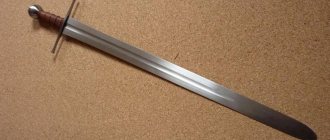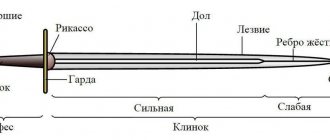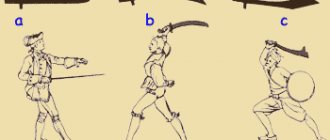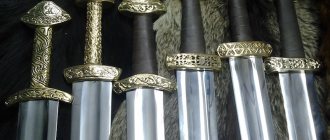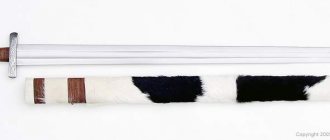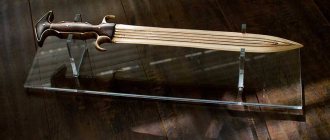Bastard sword
The sword is a murder weapon with a touch of romance. In the hands of fearless warriors, it is a silent witness to terrible battles and changing eras. The sword personified courage, fearlessness, strength and nobility. His enemies were afraid of his blade. With the sword, brave warriors were knighted and crowned persons were crowned.
Bastard swords, or swords with a one-and-a-half-handed hilt, existed from the Renaissance (13th century) until the late Middle Ages (16th century). In the 17th century, swords were replaced by rapiers. But swords are not forgotten and the brilliance of the blade still excites the minds of writers and filmmakers.
Types of swords
Longsword - long sword
Longsword
The hilt of such swords is for three palms. When you grabbed the hilt of the sword with both hands, there were a few centimeters left for one more palm. This made complex fencing maneuvers and strikes using swords possible.
The bastard or “bastard” sword is a classic example among bastard swords. The handle of the “bastards” was less than two, but more than one palm (about 15 cm). This sword is not a longsword: neither two, nor one and a half - not for one hand and not for two, for which it received such an offensive nickname. The bastard was used as a weapon of self-defense and was perfect for everyday wear.
It must be said that they fought with this bastard sword without using a shield.
The appearance of the first examples of bastard swords dates back to the end of the 13th century. Bastard swords came in different sizes and variations, but they were united by one name - swords of war. This blade was fashionable as an attribute to a horse's saddle. Bastard swords were always kept with them on trips and hikes, in order to protect themselves from an unexpected enemy attack in case of emergency.
In battles, strong blows that did not give the right to life were inflicted with a combat or heavy bastard sword.
Bastard, had a narrow straight blade and was indispensable for piercing blows. The most famous representative among narrow bastard swords is the blade of an English warrior and prince who participated in the war of the 14th century. After the death of the prince, the sword was placed over his grave, where it remained until the 17th century.
The English historian Ewart Oakeshott studied the ancient battle swords of France and classified them. He noted gradual changes in the characteristics of bastard swords, including changes in the length of the blade.
In England, at the beginning of the 14th century, a “large combat” bastard sword appeared, which was worn not in the saddle, but on the belt.
Approximate definition
Although it is vague, there are two characteristics that a real sword should have.
- It must have a longitudinal axis of symmetry - curved blades (such as a scimitar) do not belong to this type.
- It should allow for both slashing and piercing attacks. But which ones will be preferable depends on the “specialty” of the warrior, the characteristics of the potential enemy’s uniform and the tactics adopted in a given period of time.
At the same time, it is not easy to distinguish a short sword from a long dagger.
It is customary to include the Scythian akinaki among them, although archaeologists have long proven that they were exclusively piercing weapons.
Characteristics
Bastard sword and scabbard
The length of a bastard sword is from 110 to 140 cm, (weighing 1200 g and up to 2500 g). Of these, about a meter of sword is part of the blade. The blades of bastard swords were forged in different shapes and sizes, but all of them were effective in delivering various crushing blows. There were basic characteristics of the blade in which they differed from each other.
In the Middle Ages, the blades of bastard swords were thin and straight. Referring to Oakeshott's typology: Gradually the blades become elongated and thicker in cross-section, but become thinner at the tip of the swords. The handles are also modified.
The cross-section of the blade is divided into biconvex and diamond-shaped. In the latter version, the central vertical line of the blade ensured hardness. And the features of sword forging add options to the cross-section of the blade.
Bastard swords, whose blades had fullers, were very popular. The fuller is a cavity running from the cross along the blade. It is a misconception that the fullers were used as a blood drain or for easy removal of a sword from a wound. In fact, the absence of metal in the middle of the blade made the swords lighter and more maneuverable. The fullers could be wide - almost the entire width of the blade, to more numerous and thin. The length of the dollars also varied: the entire length or a third of the total length of the bastard sword.
Hand and a half sword
The crosspiece was elongated and had arches to protect the hand.
An important indicator of a well-forged bastard sword was its precise balance, distributed in the right place. Bastard swords in Rus' were balanced at a point on top of the hilt. The defect of the sword was always revealed during the battle. As soon as the blacksmiths made a mistake and shifted the center of gravity of the bastard sword upward, the sword, in the presence of a deadly blow, became inconvenient. The sword vibrated as it struck the enemy's swords or armor. And this weapon did not help, but hindered the soldier. A good weapon was an extension of the hand of war. Master blacksmiths skillfully forged swords, correctly distributing certain zones. These zones are the nodes of the blade; if positioned correctly, they guaranteed a high-quality bastard sword.
Shield and bastard sword
Certain fighting systems and varied styles made sword fighting akin to art, rather than chaotic and barbaric. Various teachers taught techniques for fighting with a bastard sword. And there was no more effective weapon in the hands of an experienced warrior. There was no need for a shield with this sword.
And all thanks to the armor that took the blow. Before them, chain mail was worn, but it was not capable of protecting the war from the blow of cold steel. Light plate armor and armor began to be forged in large quantities by master blacksmiths. There is a misconception that iron armor was very heavy and it was impossible to move in it. This is partly true, but only for tournament equipment, which weighed about 50 kg. Military armor weighed half as much, and one could actively move in it.
Not just the blade of a bastard sword was used for an attack, but also the guard as a hook, capable of knocking down the pommel.
Possessing the art of fencing, the soldier received the necessary base and could take up other types of weapons: a spear, a pole, and so on.
Despite the apparent lightness of bastard swords, fighting with it required strength, endurance and dexterity. The knights, for whom war was everyday life and swords as their faithful companions, never spent a day without training and weapons. Regular training did not allow them to lose their warlike qualities and die during the battle, which went on non-stop and intensely.
The purpose of the long blade
One-handed blades were always used more widely than two-handed blades. But towards the end of the Middle Ages, the two-handed sword gained considerable popularity in Europe. Its appearance is associated with changes in the warrior’s equipment.
The long Carolingian sword, a one-handed weapon, was convenient and effective for an experienced warrior of the Middle Ages.
It was easy to carry with you everywhere, you could fight on foot or on horseback. Due to its low center of gravity, the sword was less burdensome than a hammer or club. A soldier with it could move faster, use against the enemy not only strength, but also dexterity and speed.
In battle, the enemy was able to chop, cut, stab and simply hit flat. Some medieval drawings show that it was possible to fight even with a hilt. Since the one-handed sword was light, it was possible to hold a shield with the other hand, defending against enemy attacks.
The armor of the dawn and heyday of the Middle Ages was not very durable and was available only to the rich. The short sword coped with leather armor or a chain mail shirt without any problems.
Schools and techniques of the bastard sword
Fencing with bastard sword
German and Italian schools are becoming the most popular. The earliest manual of the German fencing school was translated, despite difficulties (1389).
In these manuals, swords were depicted as being held by two hands at the hilt. Most of the manual was occupied by a section with a one-handed sword, showing the methods and advantages of holding a sword with one hand. The half-sword technique was depicted as an integral part of armored combat.
The absence of a shield gave rise to new fencing techniques. There were such instructions on fencing - “fechtbukhs”, with manuals from famous masters of this matter. Excellent illustrations and a textbook, considered a classic, were left to us by not only the fighter, but also the wonderful artist and mathematician Albert Durer.
But fencing schools and military science are not the same thing. Knowledge from fencing is applicable to knightly tournaments and judicial duels. In war, a soldier had to be able to hold formation, hold a sword, and defeat opposing enemies. But there are no treatises on this topic.
Ordinary townspeople also knew how to hold weapons, including a bastard sword. In those days, you couldn’t live without a weapon, but not everyone could afford a sword. The iron and bronze that went into a good blade were rare and expensive.
A special technique of fencing with a bastard sword was fencing without any protection in the form of armor or chain mail. The head and upper body were not protected in any way from the blow of the blade, except for ordinary clothing.
Increased protection among soldiers contributed to changes in fencing techniques. And with swords they tried to deliver piercing rather than slashing blows. The "half-sword" technique was used.
"Naked Fencing"
Blobfechten, or "naked fencing", is a fencing technique without significant protective armor such as plate armor or chainmail. Vulnerable targets such as the head and upper torso are completely unprotected except for normal clothing during "naked" fencing. The lack of significant protection for the torso and limbs leads to the use of a large number of hacking and cutting blows, in addition to thrusting. These blows could be almost immediately fatal or incapacitating, such as stabbing the head, the heart, or a major blood vessel, causing massive bleeding. Likewise, strong slashing blows could cut through skin and bone, effectively amputating limbs. The hands and forearms are a common target for some slashing and slashing moves in a defensive or offensive maneuver, serving to cripple the opponent and allow the fencer to deliver the next blow.
Special welcome
There were many different techniques. They were used during the fight and, thanks to these techniques, many fighters survived.
But there is a technique that causes surprise: the technique of half a sword. When a warrior grabbed the blade of a sword with one or even two hands, pointing it at the enemy and trying to push it under the armor. The other hand lay on the hilt of the sword, giving the necessary strength and speed. How did the fighters avoid wounding their hand on the edge of the sword? The fact is that swords were sharpened at the end of the blade. Therefore, the half-sword technique was successful. True, you can also hold a sharpened sword blade in gloves, but, most importantly, hold it tightly, and in no case allow the blade of the blade to “walk” in the palm of your hand.
Later, in the 17th century, Italian fencing masters focused all their attention on the rapier and abandoned the bastard sword. And in 1612, a German manual was published with the technique of fencing with a bastard sword. This was the last manual on fighting techniques where such swords were used. However, in Italy, despite the increased popularity of the rapier, they continue to fencing with a spadone (bastard sword).
Bastard in Rus'
Bastard
Western Europe had a great influence on some peoples of medieval Rus'. The West influenced geography, culture, military science and weapons.
As a fact, in Belarus and Western Ukraine there are knightly castles of those times. And a few years ago, on television, they reported the discovery in the Mogilev region of knightly weapons of a Western European model dating back to the 16th century. There were few finds of bastard swords in Moscow and Northern Rus'. Since military affairs there were aimed at fighting the Tatars, which means that instead of heavy infantry and swords, another weapon was needed - sabers.
But the western and southwestern lands of Rus' are knightly territory. A wide variety of weapons and bastard swords, Russian and European, were found there during excavations.
In culture
A television
- The bastard became widespread in the series “Game of Thrones”. In addition to the fact that the bulk of Westeros warriors are armed with one-and-a-half-handed swords, in the universe of the television series there are a number of fictional named swords that are bastards: among them Long Claw, Black Flame and Dark Sister.
In video games
- The bastard sword is the main weapon of the main character of the Witcher series of games - Geralt of Rivia, as well as all other witchers.
- The bastard sword can be used as a weapon in the Dark Souls and Demon's Souls series of games. In these games it is classified as a two-handed sword.
